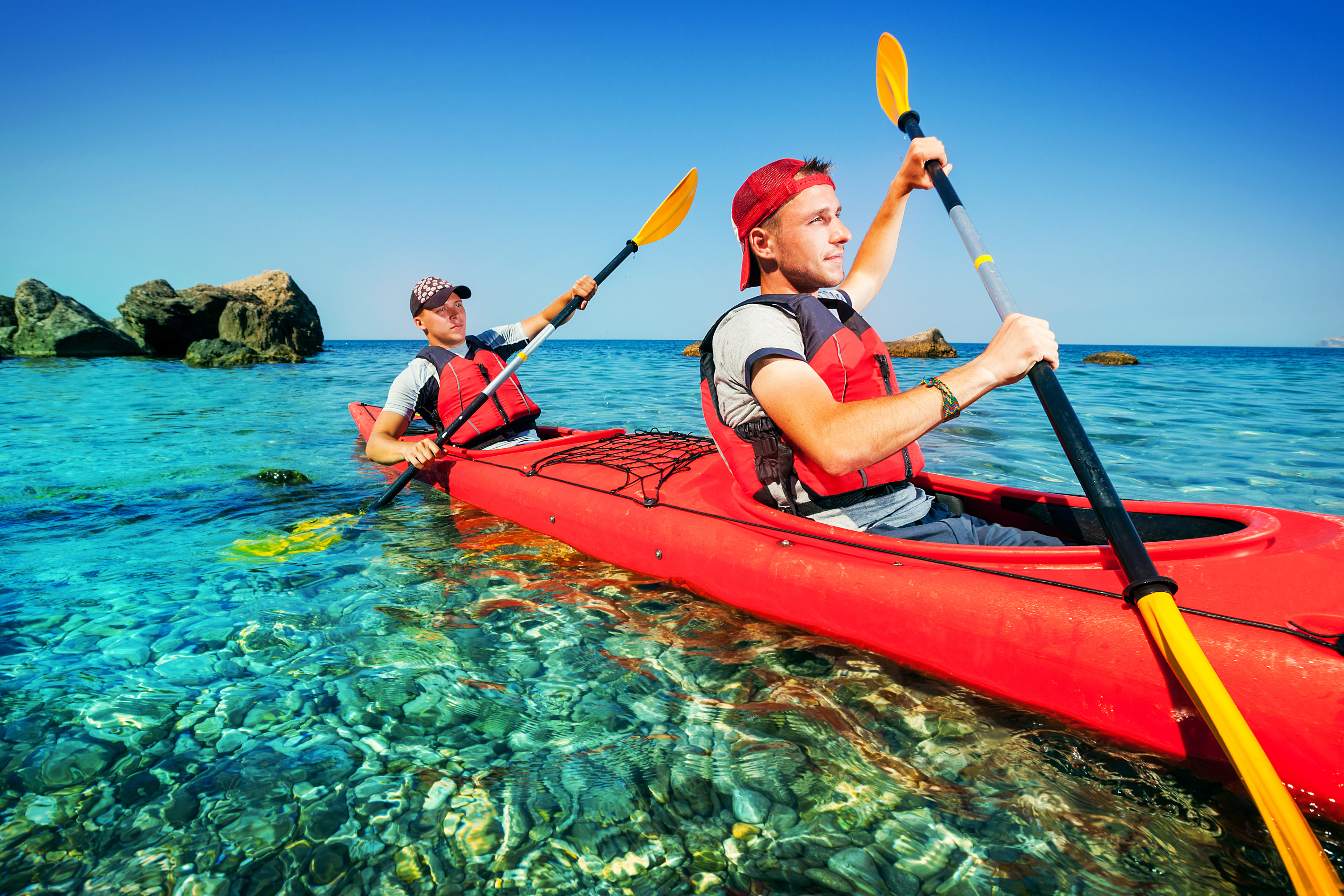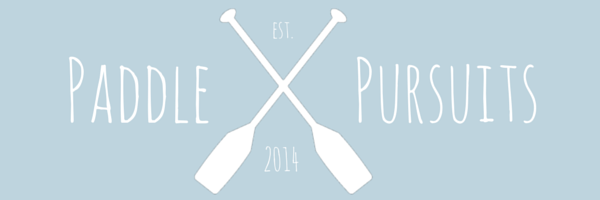
Brand new kayak strapped to the roof, dry sacks in the back, and good tunes on the radio - you’re heading out for the weekend, and it’s nothing but high hopes and fresh lake air.
Before you get too far along on your new adventure, let us help you enjoy your paddling activity with these kayaking tips for beginners.
As a paddle trip guide myself, it only makes sense to help new paddlers learn to enjoy this awesome activity!
Our 9 Kayaking Tips for Beginners
#1 Invest in a Good Paddle
This one’s from experience; invest in a good paddle which is sized correctly and as light weight as you can afford.
Don’t feel like you have to buy the most expensive paddle on the market, but investing a couple hundred bucks in your paddle will quickly bump you into the performance end of nice paddles.
Moving the paddle back and forth gets tiring after a day of paddling, and it’s a lot more rewarding to spend your energy moving the water and, therefore, the kayak rather than the paddle. Those economy paddles might suffice for your first few trips, but you’ll quickly wish you’d invested in a good paddle.
Just like heavy hiking boots make your hike more tiring, a heavy or improperly sized paddle will make your paddling trip miserable.
Choosing the right length and shape paddle for your type of kayaking is crucial. Don’t just purchase the first paddle you see; do your research!
#2 Plan to Get Wet
It’s easy to forget that a simple mistake in your kayak can leave you upside down and soaked in a split second. Even if you don’t tip, you’ll eventually get wet through paddling or camping in the rain.
Be sure to research and bring the correct layers, which include rain layers!
Always wear appropriate clothing, which means polyester, nylon, or wool. Cotton is a terrible choice of clothing for outdoor activities – it inherently absorbs more water weight and stays wet longer than synthetics.
Footwear is also imperative – you’ll want reliable and secure sandals or water shoes.
Don’t forget to pack any extra clothes in a dry sack if you’re going overnight or even on a long day trip. Always keep at least one set of clothing completely dry for wearing at night in your sleeping bag or quilt.
The topic of outdoor clothing and materials is broad but understanding this is critical for safety. Begin your research by learning how to use layered clothing systems.
#3 Learn to Use a Dry Sack the Right Way
This one might be the unsung hero tip of the day.
I can’t even begin to express how many new paddlers I see using dry bags completely wrong! They’ll be leaking water instantly, and everything inside becomes dishearteningly soaked.
Here’s the correct method for packing a dry bag:
Pack the dry sack about 2/3 full and then press the air out while holding the top together. Now fold the top rim down NO LESS than three times and buckle it.
Be careful which direction you clip the buckle, as doing this in the wrong sequence will cause the dry sack to unroll. Check it is sealed and tight by picking up the dry sack by the buckle loop.
If you’re a visual learner, here’s a quick video that shows how to fold a dry bag the right way:
#4 Practice Basic Paddling Strokes
Learning to paddle a kayak is not rocket science and, for this reason, many people never even bother to learn anything about proper paddling.
However, improving your paddling technique will make your trip faster, more efficient, and more enjoyable.
It’s worth putting in the time up front to learn proper strokes as it always leads to an improved experience on the water. If you’ve never been instructed on proper paddling technique, I suggest you watch this video.
#5 Which Knot?
Don’t have a strap to fasten the kayak to the trailer or gear rack? Got a painter line to tie off your canoe but you’re (k)not sure that you’re up for the task?
Any outdoor traveler MUST know the trucker’s hitch. This simple knot is a 2-1 pulley which can be used for very securely tying down and securing boats, tarps, or equipment.
Second up on the list of most important knots is the bowline. This classic knot won’t bind under load and won’t let you down.
Third is the Fisherman’s knot, and its closely related cousins the double and triple fisherman. With some experience and creativity, these knots will become a staple in your rope-work quiver.
For a primer on these knots and a few other kayaking related knots, start here.
Ready to graduate into the nearly endless world of knots? This amazing animated knot-tying resource will keep you busy with a piece of rope for hours.
#6 Paddle with a Friend

When you’re getting started, it’s easy to make mistakes or become nervous on the water. Like most things, having another person around just feels more comfortable, and two heads are better than one.
Check around your local area for a paddling club if you don’t know anyone with a boat. Preferably, find a partner with some experience that can offer practical, field-tested advice. It will make the learning process so much quicker and keep you safe on the water.
Sometimes a quick search will reveal local Facebook groups of yak fanatics. Alternatively, pop over to Meetup.com to look for local groups focused on outdoor activities or paddling specifically. Many areas have a paddling meetup and spending a few minutes looking might just earn you some great networking opportunities.
Don’t forget that when you paddle with a partner you can share camping equipment! Split the load by taking only one stove, one shelter, etc. No need for both of you to carry redundant gear when you can each lighten the burden by sharing.
#7 Invest in Your PFD
Once known colloquially as “life jackets”, personal flotation devices (PFDs) are not guaranteed to save your life, but instead MASSIVELY improve the chances of you doing so for yourself.
Since you’ll always be paddling in your PFD, you should consider spending a few extra Benjamins up front for quality, safety, and comfort.
Care needs to be taken when choosing and sizing a PFD. Inarguably the most important factor in choosing your PFD is comfort. Make sure that the PFD you choose fits well and do yourself a favor by going in person to a store to try them on.
Kayaking PFDs are specific for paddling sports and fit differently than that old floaty vest your mom made you use as a kid in the pool.
Be sure that your PFD provides ample room to move your arms freely in the paddling stroke and won’t cause chafing. You don’t want your underarms rubbed raw like meat patties three days down the river.
#8 Know the River Hazards

Before paddling on a river, be sure to educate yourself on the potential dangers. Many beginner paddlers are blissfully ignorant of the inherent dangers of river paddling and, without proper education, you may end up injured – or worse.
If you’re not sure what a strainer is, or the difference between downstream and upstream V’s, then you’re probably not adequately prepared to paddle the river.
Clueing yourself up on the technical details of river hazards is essential for river paddlers even if you’re not attempting whitewater. You’ll notice a few recurring themes such as “understand your true paddling abilities” – don’t let ego get you in literally over your head.
#9 Take a Whistle and Know Hand Signals
Many beginners don’t realize how loud the river can be. If you’re paddling any distance from your partner on a turbulent river, the noise of flowing water can quickly drown your ability to communicate.
This is especially true on whitewater rivers but, hopefully, you’ll be avoiding those as a beginner!
There are predefined paddle, hand, and whistle signals which are followed by educated paddlers. Be sure to at least familiarize yourself with them before heading out, you never know when you’ll need them.
Here’s a great look at the established river signals from the international rafting federation.
Conclusion
These nine helpful kayaking tips for beginners are the things I wish I’d known when I started kayaking.
Leading paddling trips over the years, I’ve learned to help provide these valuable foundational pieces of knowledge to beginners and now, hopefully, they can help you have fun and stay safe.
Kayaking is a great way to travel in the outdoors, and you’ll learn to love it with a little forethought and the proper knowledge to enjoy the water.
Did you enjoy these little tidbits of knowledge? Got one of your own? Leave us a line in the comments!
As an Amazon Associate, we earn from qualifying purchases. This is without any additional costs for the buyer but does support us in maintaining our website.




I’m wanting to start getting into kayaking as it looks like something that I would thoroughly enjoy myself while doing. I liked that you had mentioned that it can be important to invest in a good paddle to make sure you’re getting the most out of the energy that you’re exerting. Once I can get my wife’s approval to actually purchase a kayak, I’ll be making sure that I get a nice paddle with it as well.
Both styles of kayaks are useful to fisherman and within each style there are models that will suit you better than others. Let’s get back to some of those earlier questions and see why they’re important in helping you choose which of these types of kayak will be best for you.
These are great tips for beginners. It is all too often that people think that since they can swim they do not need a PFD. Thank you for adding in the use of a life jacket. It should always be safety first.
My cousin has been thinking about going kayaking with some of his friends for the first time. He would really like to buy one from a professional to make sure that it will look nicer. I liked what you said about how he should get a kayaking life jacket because it is different from floaty vests, and should be more comfortable, safe, and of higher quality.